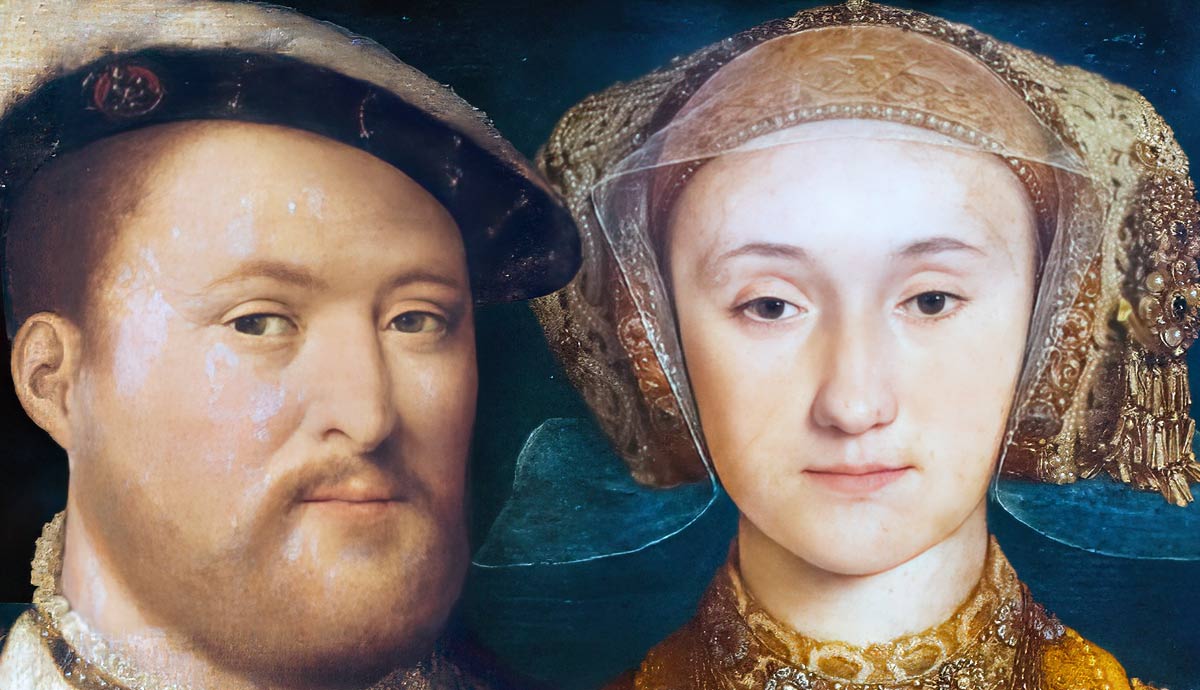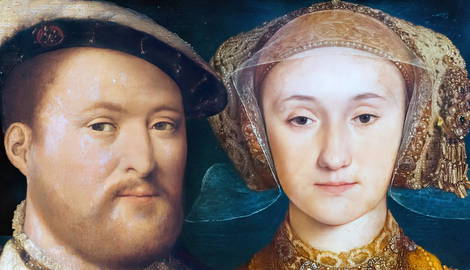
summary
- Unappealing Appearance: Henry VIII annulled his marriage to Anne of Cleves due to a lack of consummation, citing her unappealing looks, though no other contemporaries complained about her looks.
- Brotherly Affection: Despite the annulment, Henry showed Anne great affection, referring to her as his “dearest sister” and providing a generous divorce settlement.
- A Happy Life: For the rest of Henry’s life, Anne lived in comfort, maintaining a respected position at the English court.
Anne of Cleves is often characterized as Henry VIII’s least favorite wife. The infamous womanizer had his marriage to her annulled on the basis that her looks were so unappealing that he could not consummate the union. But the evidence of Henry’s treatment of Anne after their divorce suggests that she held a special place in his heart, though as a sister and friend rather than a lover. In fact, she may have been the luckiest and most beloved of all his six wives.
Introducing Wife Number Four

Anne of Cleves was King Henry VIII’s fourth wife. Catherine of Aragon was divorced in 1533, Anne Boleyn was beheaded in 1536, and Jane Seymour died in 1537. The king’s wedding to Anne of Cleves took place on the 6th of January 1540. This was the annual celebration of the Feast of the Epiphany, which also marked the culmination of King Henry’s Christmas festivities. This event was intended to be filled with warmth, joy, and romance.
Despite the happy occasion of their wedding, their union lasted just six months. Anne and King Henry formally separated on the 9th of July that same year, having failed to fall in love with each other and, more importantly, consummate their relationship.

Anne had the misfortune of succeeding Jane Seymour, the woman traditionally thought to have been the greatest love of King Henry’s life. When he married Anne, King Henry’s heart was still breaking over the premature death of his beloved Jane. We know that King Henry never really recovered from the loss of his third wife. Even when married his sixth wife nearly a decade later, it was the deceased Jane Seymour he had painted into his family portrait, rather than the living Catherine Parr.
To make matters worse for Anne, Jane had been the perfect example of a 16th-century wife. She had been beautiful, meek, pious, kind-hearted, and agreeable. What’s more, she had provided England with a healthy and legitimate heir. What woman in her right mind would have wished to follow her?
As a result, Anne is remembered as being a particularly unappealing, indeed so unattractive that King Henry was unable to do his duty as a husband. Consequently, she is often described as the wife Henry liked the least.
Who was Anne of Cleves?

Anne of Cleves was born in Dusseldorf, Germany, in 1515. At the time of her birth, King Henry had already been King of England for six years and was happily married to his first wife, Catherine of Aragon.
Anne’s father was John III of the House of La Marck, and her mother was Maria, the Duchess of Julich-Berg. She was the second of their four children. Her siblings were Sibylle (1512-1554), who would later marry the Elector of Saxony, Wilhelm (1516-1592), who would receive the Dukedom of Julich-Cleves-Berg, and Amalia (1517-1586), who would, despite her parents’ best efforts, remain unmarried until her death.
This small nursery possessed a grand and prestigious lineage. Each child was descended from various Kings of both England and France and held particularly close ties to King Louis XII of France and the Duke of Burgundy.
The children spent their earliest years together in extremely close quarters, but girls were poorly educated and prepared only for a life of Royal housekeeping and motherhood. Their limited and old-fashioned schooling consisted mainly of painting, needlework, household management, music, dancing, and card games. Nevertheless, the girls represented valuable prizes on the European marriage market.

In 1527, when Anne was 11, she was betrothed to Francis, the nine-year-old son and heir of Antoine Duke of Lorraine. However, because Francis was under the age of consent for marriage, ten in Germany at the time, the betrothal was later considered unofficial. Nevertheless, the issue of this pre-contract would provide Henry with grounds for him to question the validity of his own marriage to Anne later.
In 1539, Thomas Cromwell, the man who eventually lost his head for his involvement in this marriage contract, first contacted the Cleves family to propose a union between King Henry and one of the daughters. Hans Holbein the Younger was sent to paint reliable depictions of both Amalia and Anne so that King Henry could choose which he would prefer. He selected Anne.
Was Anne of Cleves “The Ugly One?”

It is entirely possible that Anne of Cleves was no great beauty. But is there any reliable evidence to support the theory that Anne was particularly unpleasant to look upon? The likelihood is that Anne was no less attractive than any other woman King Henry had ever encountered. True, she may not have possessed the same allure and sex appeal as Anne Boleyn, and she may have lacked the English-Rose-style beauty of Jane Seymour. But King Henry was the only person who ever saw fit to complain about her.
Edward Hall (1498-1547) gave extremely favorable descriptions of Anne’s appearance. He described her hair as being “long, yellow, and fair.” He stated that she dressed in English fashion but with a French hood, which at the time would have been the height of fashion. Hall even went as far as to say that her clothes “set forth her beauty and good visage so much that every creature rejoiced to behold her.”

Charles de Marillac (1510-1560), the French Ambassador, described her as being “tall and slim, of middling beauty,” and of a “very assured and resolute countenance.”
While these are not the most flattering descriptions a woman could wish to hear, they paint the picture of a wealthy, striking, confident, well-dressed, well-maintained, and averagely pretty woman. The disappointed King Henry claimed, “I see nothing in this woman as men report of her.”
Several portraits of Anne also survive by various artists. Hans Holbein the Younger (1497-1543), Cornelis Martinus Vermeulen (1644-1708), Adriaen van der Werff (1659-1722), and John June (1740-1770) are just a few of the men who captured her likeness. So often has she been painted that London’s National Portrait Gallery alone is home to 14 such depictions.

The image we are most familiar with is undoubtedly the version of Anne painted by Hans Holbein the Younger, commissioned by King Henry himself in 1539. It is this depiction of Anne that King Henry laid his own eyes upon long before he laid eyes upon the woman in the flesh. To the modern eye, a portrait of Anne of Cleves looks very much the same as a portrait of Catherine Howard, Catherine of Aragon, or any other woman of the era.
One interesting piece of evidence suggests that Anne of Cleves believed herself to be attractive. She went as far as to declare to her friends that she possessed better looks than Catherine Parr. According to reliable reports, when it was announced that King Henry was to marry once again, Anne remarked to her ladies that she was a good deal more attractive than the Queen-to-be. She also mentioned, perhaps in a bout of jealousy, that Catherine was unaware of what she was taking on in marrying King Henry.
It was Eustace Chapuys (1489-1556), the Imperial Ambassador, who just happened to overhear this conversation. Whether he approved or disapproved of Anne’s confidence is unclear. But since he was a man who did not usually have trouble expressing his opinion if he had thought her comments laughable, he very likely would have recorded it.

Predictably, casting directors of our era have not yet cared to appoint an unattractive Anne. Over the last century, she has been portrayed by a wide variety of beautiful women, including Elsa Lanchester in The Private Life of King Henry VIII (1933), Pia Girard in King Henry VIII (2003), Joss Stone in The Tudors (2007), and Rebecca Dyson-Smith in the documentary series, Six Wives With Lucy Worsley.
The reasons for King Henry’s criticism of Anne’s appearance are clear. What King of England would publicly admit his inability to consummate a marriage? There was no one for him to blame for this failure other than his wife.
Did Henry Have Affection for Anne of Cleeves?

King Henry did not love Anne of Cleves as devotedly as he had loved Catherine of Aragon. He was not as infatuated with Anne of Cleves as he had been with Anne Boleyn. He did not treasure her as he had treasured Jane Seymour. He did not lust after her in the same way he would lust after Catherine Howard, and he did not trust her and rate her as highly as he would trust and rate Catherine Parr.
However, there is evidence to support the idea that he harbored a genuine, brotherly affection for Anne. There is a wealth of material to confirm the notion that he thought of her with warmth and friendship, so much so that they might have been better suited as platonic companions than as husband and wife.
Henry and Anne’s First Meeting

Even before their first meeting, King Henry had decided that his marriage to Anne was going to be a success. Having decided that he was in love with her after only a few positive descriptions from Thomas Cromwell and a swift glance at her portrait by Holbein, he was hardly able to wait for her arrival in England. So excited had he been to lay eyes upon her in the flesh that he had ridden out with a group of companions, in true Arthurian fashion, to surprise her with an early rendezvous. To make matters worse, he had come up with the ingenious idea of disguising himself as a lowly messenger and testing Anne on her ability to recognize true love.
The curators of Hampton Court Palace tell us that “while on the way to London, Anne was surprised by a group of masked men, led by a tall, burly middle-aged man who tried to kiss her. Anne, unused to such behaviour, pushed him away in bewilderment.”
Anne had thought that she had several days left to prepare herself for her first meeting with her future husband and was horrified when this group of rowdy and excitable gentlemen burst in on her and her temporary household unexpectedly. The Royal-blooded Catherine of Aragon, the sophisticated Anne Boleyn, and the well-prepared Jane Seymour would have recognized this for what it was, a game of chivalric tradition and courtly love. However, the foreign and ill-prepared Anne of Cleves was completely caught off guard by what she perceived to be a random attack.

We are told that, immediately upon seeing his soon-to-be bride, King Henry took her in his arms and kissed her. We can take this as a sign that he was initially pleased. He found her attractive enough to pay her the compliment of physical affection.
Unfortunately, Anne did not recognize King Henry as quickly as he had hoped, and it was after this fiasco that things swiftly went downhill. Perhaps if their first meeting had gone as planned, and if their relationship had not started out with confusion and miscommunication, it might have had more of a chance at survival.
The Unhappy Marriage of Henry and Anne?

Anne had no complaints about her marriage. If she thought there was something wrong with her marriage, she certainly did not voice her concerns to those around her. Instead, she complimented King Henry as a sweet and kind-hearted husband. In February, just a month after their wedding, Anne told the Countess of Rutland that she and he conversed twice daily.
“When he comes to bed,” Anne began, “he kisseth me, and taketh me by the hand, and biddeth me ‘good night, sweetheart.’” She continued, “and in the morning he kisseth me and biddeth me ‘farewell, darling.’”
Henry and Anne’s Divorce Settlement

Henry granted Anne a generous divorce settlement. The best that most ex-queens could hope for was a life in obscurity. Most would have been thankful for the chance to live out their days in a prestigious but quiet countryside Abbey. But Anne of Cleves was granted the greatest gift King Henry could have given, the chance to begin her life again. As far as King Henry was concerned, Anne had done nothing wrong. Therefore, it made no difference to him if she enjoyed what she was technically owed as a former Queen of England.
Anne received an extremely generous divorce settlement. She was given manors in Hampshire formerly owned by Breamore Priory and Southwick Priory and, even more excitingly, Hever Castle, the childhood home of the deceased Anne Boleyn.
Anne was free to remain in England and to live as a private person in her own right. She was answerable to no one but the King, and since by this time he was planning to spend most of his time in bed with Catherine Howard, he had very little care for what his ex-wife might do.
Since King Henry confirmed that Anne was still a virgin, she was free to marry whoever she chose. Unsurprisingly, this was one opportunity she chose not to take.
Finally, Henry placed her above almost all other women in England. After her divorce, Anne was hardly treated as an outcast. Instead, she was considered an honorary member of King Henry’s family. Anne and King Henry grew to like each other, probably much more so than they had when they were married, and even became fond of each other’s company.
King Henry insisted that all should refer to Anne as “the King’s beloved sister.” Such was her favor that he decreed she was to be given precedence over all other women in England, save his own wife and daughters.
Anne Of Cleves: The Wife Who Lived

“Divorced, beheaded, died; divorced, beheaded, survived.”
Over the last five centuries, historians have been conditioned to believe that it was Catherine Parr who was the most successful of King Henry’s wives. She is the queen who appears with a resounding victory at the end of the verse written above. Traditionally, it is she who is remembered as “the one who survived.”
While Catherine of Aragon suffered in exile, Anne Boleyn and Catherine Howard lost their heads, and Jane Seymour died in agony bearing a Prince, Catherine Parr managed to avoid the inevitable without so much as a scrape on her hand. So relieved are we to hear of her narrow escape that we can almost forget that she died just a year later while bearing the child of her final husband, Thomas Seymour.
Although she is labeled simply as “the one who was divorced,” it was Anne of Cleves who survived King Henry the longest. Her life went on for another decade after his death, having been provided with a clean slate and a good chance of happiness, she certainly made the most of that life. Anne did not live in obscurity after her husband’s death, but made many notable public appearances. Most significantly of all, she took part in the Coronation procession of her daughter-in-law, Queen Mary I, on the first of October in 1553.

Anne’s only sadness was that she never had the chance to return home to Germany. Evidence suggests that she was generally content in England, but she did express the occasional bout of homesickness in her letters.
Anne died at Chelsea Old Manor on the 16th of July, 1557. The most likely cause was an unknown form of cancer. Just a few weeks later, on the 4th of August, Anne was buried in Westminster Abbey. She received Catholic rites, as she had requested.
Anne mentioned many friends and family members in her will. These included her brother, her sister, and her sister-in-law, as well as Queen Mary, the future Queen Elizabeth, the Duchess of Suffolk, and the Countess of Arundel, all of whom she counted among her closest friends. She left money and belongings to each of her favored servants and beseeched Mary and Elizabeth to employ them in their households.
Raphael Holinshed (1525-1582) described Anne as “a lady of right commendable regard, courteous, gentle, a good housekeeper, and very bountiful to her servants.” He confidently stated that there had never been “any quarrel, tale bearing or mischievous intrigues in her court, and she was loved by her domestics.” Anne was remembered by everyone who served her as a kind, fair, and easy-going mistress. It seems that nobody had a bad word to say about her.

The body of Anne of Cleves now lies on the South Side of the High Alter at Westminster Abbey. According to the Abbey, “her monument is a low stone structure of three sections with carvings showing her initials with a crown, lions heads and skulls and crossed bones.” Her Epitaph simply reads “Anne of Cleves, Queen of England, born 1515, died 1557.”
Anne Of Cleves: The Wife King Henry Loved Most?

While Anne of Cleves may not have been the wife King Henry loved most, there is absolutely no doubt that he genuinely liked and respected her as a woman in her own right. Certainly, she was not the despised and ill-treated Queen that so many people now perceive her to have been.
On the day his marriage to Anne was annulled, King Henry delivered to her a comforting letter. “You shall find us a perfect friend,” he assured her, “content to repute you as our dearest sister. We shall, within five or six days, determine your state minding to endow you with four thousand pounds of yearly revenue, from your loving brother and friend.”
If that is not good enough proof of King Henry’s affection for Anne, what is?










